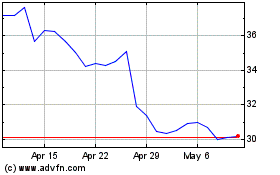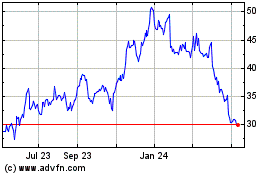By Ted Greenwald
This article is being republished as part of our daily
reproduction of WSJ.com articles that also appeared in the U.S.
print edition of The Wall Street Journal (April 27, 2018).
Intel Corp.'s quarterly profit surged as the chip giant showed
no impact of revelations earlier this year of critical security
flaws in its processors.
Profit in the first quarter grew by 50% from a year earlier to
$4.45 billion. Revenue rose 9% to $16.07 billion.
Sales in the division responsible for server chips and other
data-center gear rose 24%, notching important growth in the highly
profitable segment. Intel is leaning on the unit, which typically
makes up around one-third of its revenue, as sales of personal
computers give way to mobile devices and smart speakers.
Sales of data-center equipment to cloud providers grew 45% from
a year earlier, while sales to network operators were up more than
30%. Enterprise sales edged up 3%, the company said.
Executives on its conference call attributed that growth to
corporate spending to keep proprietary data on-site rather than in
the cloud.
Revenue from the division that sells chips for PCs, which
generally makes up more than half of revenue, rose by 3%, despite
declining PC shipments in the quarter, according to Gartner
Inc.
Intel's shares were up 5.3% to $55.86 after hours. The stock has
gained 15% this year and 44% over the past 12 months.
The chip giant raised its full-year revenue forecast nearly 4%
to $67.5 billion, and raised its earnings outlook based on strong
revenue growth, lower spending and a lower tax rate. It also
boosted its operating margin projection to 29% from its prior
forecast of 28%.
The quarter's results and raised forecast show "the acceleration
of our transformation from a PC-centric company to a data-centric
company," Intel finance chief Bob Swan said in an interview.
Intel's progress has hit a snag, though, as it has slowed its
shift to a next-generation manufacturing recipe designed to produce
smaller, more powerful circuitry. The company now expects the new
10-nanometer process to reach volume production in 2019, instead of
this year.
"Yields are improving," Mr. Swan said, but they are "not
improving at the rate we anticipated." The delay has let competing
chip foundries narrow a manufacturing lead that long has been a key
Intel advantage.
The otherwise positive results came despite the revelation in
January of security flaws that afflict a wide variety of
processors, including virtually all the ones Intel made in the past
decade.
The flaws hit Intel especially hard, as it holds around 95%
market share in chips for PCs and servers, according to Mercury
Research.
Intel has said the problem would have no material impact on its
finances, and it would fix the vulnerabilities in new chips due
this year. The chip maker earlier in April said it had issued
firmware updates addressing two of the three known flaws, known as
Spectre and Meltdown, for all its affected processors introduced in
the last nine years.
Intel's overwhelming dominance in processor chips makes it a
target for Advanced Micro Devices Inc., which has been rolling out
competitive products for the first time in years, recently shipping
its second generation of desktop chips.
AMD reported Wednesday revenue in its division that sells PC
chips ballooned 95% in the first three months of 2018, a sign the
business is gaining traction. AMD said profit came to $81 million,
compared with a $33 million loss a year ago.
Intel scored a coup against its rival, though. Jim Keller,
architect of AMD's latest chips as well as heading Tesla's
Autopilot system and developing chips for Apple Inc.'s iPhones, is
joining Intel as head of hardware engineering. He will be reunited
at Intel with Raja Koduri, his partner at AMD and Apple, who joined
as chief chip architect in November.
And with PC sales in persistent decline, Intel is forging into
new markets in search of faster growth.
Memory-chip revenue grew 20% from a year ago, but the division
failed to notch its second consecutive quarter of profit largely
because of investments in manufacturing capacity, Mr. Swan said.
Intel's finance chief said he expects the memory division would be
profitable for the full year.
Revenue in the internet-of-things segment, which sells chips
that outfit a variety of devices with computing and communications
capabilities, was up 17%, while sales in the division that sells
programmable chips rose by the same margin.
Excluding items such as restructuring and acquisition-related
costs, Intel reported per-share earnings of 87 cents. Analysts
surveyed by Thomson Reuters had expected adjusted earnings of 72
cents a share on revenue of $15.07 billion for the quarter.
For the current quarter ending in June, the company forecast
adjusted per-share earnings of 85 cents on revenue of $16.3
billion.
Corrections & Amplifications Sales in the division
responsible for server chips and other data-center gear rose 24%,
notching important growth in the highly profitable segment. An
earlier version of this article incorrectly stated the rise was
25%. (April 26, 2018)
Write to Ted Greenwald at Ted.Greenwald@wsj.com
(END) Dow Jones Newswires
April 27, 2018 02:47 ET (06:47 GMT)
Copyright (c) 2018 Dow Jones & Company, Inc.
Intel (NASDAQ:INTC)
Historical Stock Chart
From Mar 2024 to Apr 2024

Intel (NASDAQ:INTC)
Historical Stock Chart
From Apr 2023 to Apr 2024
